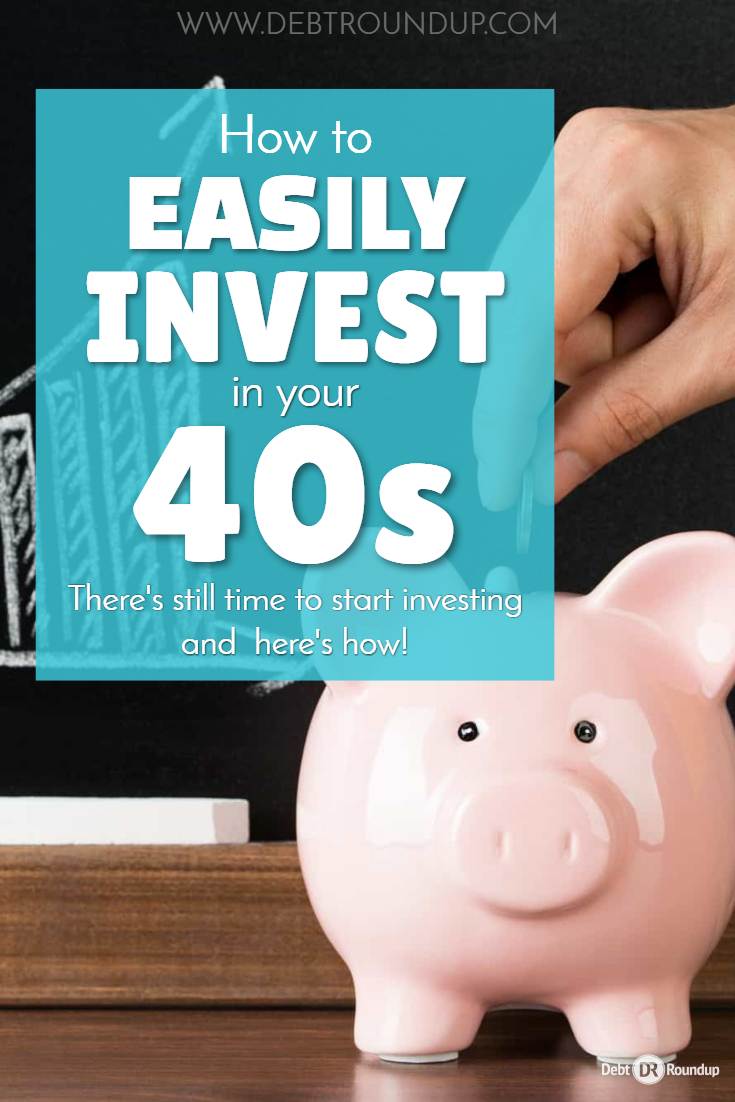How to Easily Invest in Your 40s

Is time running out when you need to invest in your 40s? We here at Wealth Bytes don’t think so. As part of our investing series, we’re here to show you how to easily invest when you are in your 40s. We’ve already covered investing in your 20s and investing in your 30s, so it’s time to tackle those of you in your 40s.
Your 20s and 30s are an exciting time as you climb the corporate ladder, start a family, and make your first large purchases such as buying a house, nice car, and a dream vacation. This doesn’t mean the next decade of life, your 40s, are any less exciting. Your 40s are the beginning of your peak earning years and a time when you will make many important financial decisions that determine if you can retire on schedule. If you feel overwhelmed financially, you can easily invest in your 40s with confidence.
Repay Your Debts
Your 40s and 50s are your “peak earning years” as you finally have some career stability and are near the top of the corporate ladder. You might be earning as much in one week as it took you a month to earn during your 20s. Instead of spending that extra money on inflating your lifestyle by buying a fancier car, bigger house, or going on a fancier vacation.
Make it a goal to be debt-free before you turn 50. That means making extra payments on your mortgage, car loans, or any other monthly debt payments. You still have time in your 40s and 50s to invest a lot of money and earn a decent return before you reach retirement and begin living on your passive income.
Using a free net worth calculator like Personal Capital can help you visualize your financial goals in a matter of minutes and track your progress in real-time!
Investing vs Paying for College
Another decision you will need to make during your 40s is whether to pay for your children’s college degree or put the additional money to saving for retirement and becoming debt-free. While the goal of every parent is to see their children enter the workforce debt-free, it’s not always possible.
Because college is so expensive (a 4-year degree can easily cost $57,000 per child), you should contribute what you can to help financially, but, you shouldn’t forsake your retirement so he can graduate without student loans. At the end of the day, you only have 20-25 “good” working years left to save for retirement. Your children have 40 years to save for retirement.
By getting out of debt as soon as possible, you can even have the financial flexibility to invest and pay for college simultaneously.
How Much to Invest in Your 40s
There are many different suggestions for how much you should invest in your 40s. Your contribution percentage ultimately depends on how much you invested in your 20s and 30s and how the lifestyle you want to live in your retirement years.
These are a few basic rules to follow:
- Invest 25%-35% of Your Income
This number might seem a little high. It depends how much you contributed in your younger years. If you invested at least 10-15% in your 20s and 30s, you can contribute a lesser amount because you don’t have to “catch up.”
If you are just now starting to invest for retirement, aim for the 35% mark. You might not be able to contribute that much right away because of mortgage payments or other financial obligations. Once you repay those loans, invest the money that used to make the monthly payment. You are already used to not spending it so it might not be as difficult as you think.
Once again, use the Personal Capital financial tools or talk with an investment advisor to make an investing plan that fits your financial situation. The important thing is to start investing today.
- Multiply Your Initial Retirement Budget By 25
Once you have an idea of how much you plan to spend during your first year in retirement, multiply that figure by 25. This assumes you will live on your retirement savings for 25 years. The last thing you want to do is outlive your savings and radically alter your lifestyle to make ends meet.
For example, if you plan on traveling in an RV for 9 months of the year, your expenses will probably be higher than somebody that works in their garden at home. Unless you can get paid to travel, you will need to save for your retirement hobbies and still afford the basic life expenses.
How to Allocate Your Investments
A general rule of thumb is that you should invest 80% of your assets in stocks and 20% in bonds during your 40s. If you have a lower risk tolerance, you might decide to have the percentage of bonds mimic your age. Following this strategy means you would invest in 40% bonds at age 40 & 45% bonds at age 45, etc. Just remember that bonds historically underperform stocks and you run the risk of not saving enough.
To make it easy, your brokerage will have you complete an investment questionnaire to determine the correct stock and bond allocation for your age and financial goals. It’s okay to still be aggressive when investing in your 40s.
Where to Invest in Your 40s
The key to maximizing your earning potential is to choose investments with the lowest expenses. The obvious choices are index mutual funds and ETFs that seek to match the performance of a specific market index like the S&P 500 or the Dow Jones Industrial Average, instead of solely relying on the performance of a single stock which can be quite risky.
When you don’t want to deal with the hassle of making sure exactly 45% of your portfolio is large cap stocks or you have 15% invested in international funds, using an automated portfolio from Betterment, Wealthfront, or Motif Investing give you diversification for a very small management fee.
If you feel comfortable investing yourself, all the leading brokerages like TD Ameritrade, Charles Schwab, Vanguard, Fidelity, and TradeKing allow you to trade stocks, bonds, mutual funds, ETFs for a few dollars per trade or even for free.
You might also consider investing in target date retirement funds that will automatically shift the fund investments from an aggressive strategy to a passive strategy as it approaches the scheduled retirement year. These funds can be cheaper than hiring an actual manager, but, it can still be cheaper (& a potentially larger earning potential) with a robo-advisor platform like Betterment that offer similar services.
Summary
Your 40s is a perfect opportunity to invest during your peak earning years and follow an aggressive investment strategy. The two largest challenges are paying off any debt you have incurred during your 20s and 30s and how much many you want to spend on your children as they transition from childhood to adulthood.

